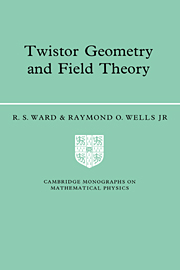3 - The algebraic topology of manifolds and bundles
from Part I - Geometry
Published online by Cambridge University Press: 08 October 2009
Summary
An important ingredient in modern geometry has been the development of topological methods for the study of analytic problems. The solutions of the various types of field equations which we shall encounter in Part III will necessitate a familiarity with various tools which have been developed in the past several decades. The study of manifolds was initiated by Riemann in his study of Riemann surfaces. This was continued in the late nineteenth century by the research of Betti who developed the first topological invariants which transcended the original Euler characteristic of a polyhedral surface S (X(S) = V - E + F, where V is the number of vertices, E is the number of edges, and F is the number of faces). After this, the fundamental work of Poincaré at the turn of the century gave the impetus to make topology a full-fledged mathematical discipline, with the study of manifolds being one of the central problems. The notion of topological invariants of topological spaces has played a critical role in these developments. These invariants are numbers or algebraic objects which one associates with geometric objects, and which help to classify them. We shall see in §3.1 a survey of the basic elements of homology and homotopy invariants which will be important for our field-theory investigations.
- Type
- Chapter
- Information
- Twistor Geometry and Field Theory , pp. 148 - 238Publisher: Cambridge University PressPrint publication year: 1990



